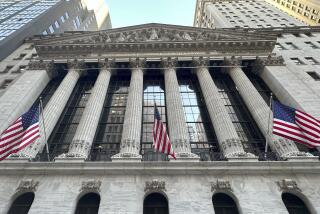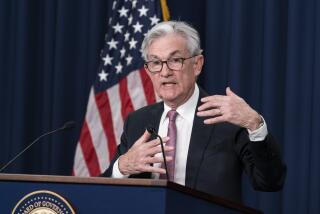Inflation rises again in May
WASHINGTON â Energy prices are climbing at nearly twice last yearâs pace and food costs are also ratcheting higher, putting an ever-tighter squeeze on consumers, the government reported Friday.
Most people would consider that bad news for the economy, not to mention average Americans. But Wall Street took solace in the fact that, aside from fuel and food, inflation hadnât spread throughout the broader economy.
That helped trigger a rally in stocks, with the Dow Jones industrial average rising 165.77 points, to 12,307.35.
The market move, which was helped by a drop in crude oil prices, came after the Labor Department reported that consumer prices leaped 0.6% in May, the biggest one-month increase in the so-called headline rate since November.
But stock investors tend to keep a closer watch on the âcoreâ inflation rate, which excludes prices for food and energy. That indicator came in at a modest 0.2%. Some economists think it might allow the Federal Reserve to be less aggressive in hiking interest rates to tame inflation.
âUnderlying core inflation remains low and stable,â said Mark Zandi, chief economist at Moodyâs Economy.com. âIf you take that by itself, it would suggest the Fed could keep interest rates stable through the end of the year.â
As crude oil prices have skyrocketed, sending average gasoline prices past $4 a gallon nationwide, investors have grown increasingly concerned that the Fed was poised to tighten the credit spigot.
Those fears intensified after Fed Chairman Ben S. Bernanke gave a speech late Monday warning of the ongoing danger of inflation.
âThus far, the pass-through of high raw materials costs to the prices of most other products and to domestic labor costs has been limited,â Bernanke said.
âHowever, the continuation of this pattern is not guaranteed, and future developments in this regard will bear close attention,â he said.
For most of the last year, the Fed has been easing credit, hoping to keep the slowing economy from stalling out and to counteract the credit crunch triggered by the collapse of the housing market.
The central bankâs benchmark federal funds rate is now just 2%, and its policymaking committee is scheduled to meet this month to evaluate whether it should raise the rate, cut the rate or let it be.
In that context, the news that core inflation was holding steady seemed to suggest that the Fed, too, would hold steady, at least for the time being.
âI wasnât surprised the markets took it as good news,â Peter Kretzmer, senior economist at Bank of America, said of Fridayâs inflation report.
âThe context is that this week, the markets became convinced that policymakers are finally concerned that inflation is about to rise and the low-inflation environment that the Fed has taken a generation to create was about to fly out the window,â he said. âAnd then we got a core inflation rate that looked pretty much like the other reports we were getting this year.
âIt wasnât good, but the leakage of energy prices into prices in the rest of the economy didnât get worse.â
Over the last 12 months, the overall inflation rate was 4.2% and the core rate 2.3%.
The Labor Department said the increase in overall inflation for May was driven by a huge 5.8% rise in the price of petroleum-based products. Energy costs increased 16.5% in the first five months of this year, nearly as much as the 17.4% they climbed in all of 2007.
Energy factors into the cost of nearly all goods and services. But businesses, reluctant to raise prices, have largely been absorbing the added expense in an effort to keep customers happy.
Some analysts donât think companies can continue eating these costs much longer.
âCompetitive pressures tend to make firms loath to raise prices. Theyâve been waiting for oil prices to break,â said Ken Beauchemin, an economist with Global Insight, an economic forecasting firm in Lexington, Mass. âBut now itâs looking like this [rise in energy costs] is permanent, and so firms are just going to throw in the towel and raise prices.â
Although many categories of prices stayed steady, Beauchemin pointed to the 3.2% increase in airline fares in May, which he suggested could be a harbinger of price jumps to come in other industries.
Bond traders appear to be betting that the Fed will raise interest rates later this year. Treasury bond yields were mixed after the inflation numbers were released Friday, with the 10-year T-note climbing to 4.26%, up from 4.21% and the highest level since late December.
At the same time, the Fed must keep an eye on the troubled housing market and the risk that a rate hike could further weaken the economy, said Lee Ohanian, an economist at UCLA.
âI would not take any significant steps now because we still have this housing issue,â Ohanian said, adding that an interest rate boost would âhave a very negative effect on the value of homes and our ability to clean up the sub-prime mess.â
Ohanian said that inflationary pressures might ease slightly as higher prices lead oil producers to increase supply and oil consumers to decrease demand. But he believes that consumers and investors alike are beginning to adjust to a new reality of permanently higher fuel prices.
âIt would be wonderful to live in a world where oil was $50 a barrel again,â Ohanian said. âBut we donât and weâre never going back to that, and thereâs nothing anyone in the United States can do about it.â
--
More to Read
Inside the business of entertainment
The Wide Shot brings you news, analysis and insights on everything from streaming wars to production â and what it all means for the future.
You may occasionally receive promotional content from the Los Angeles Times.









